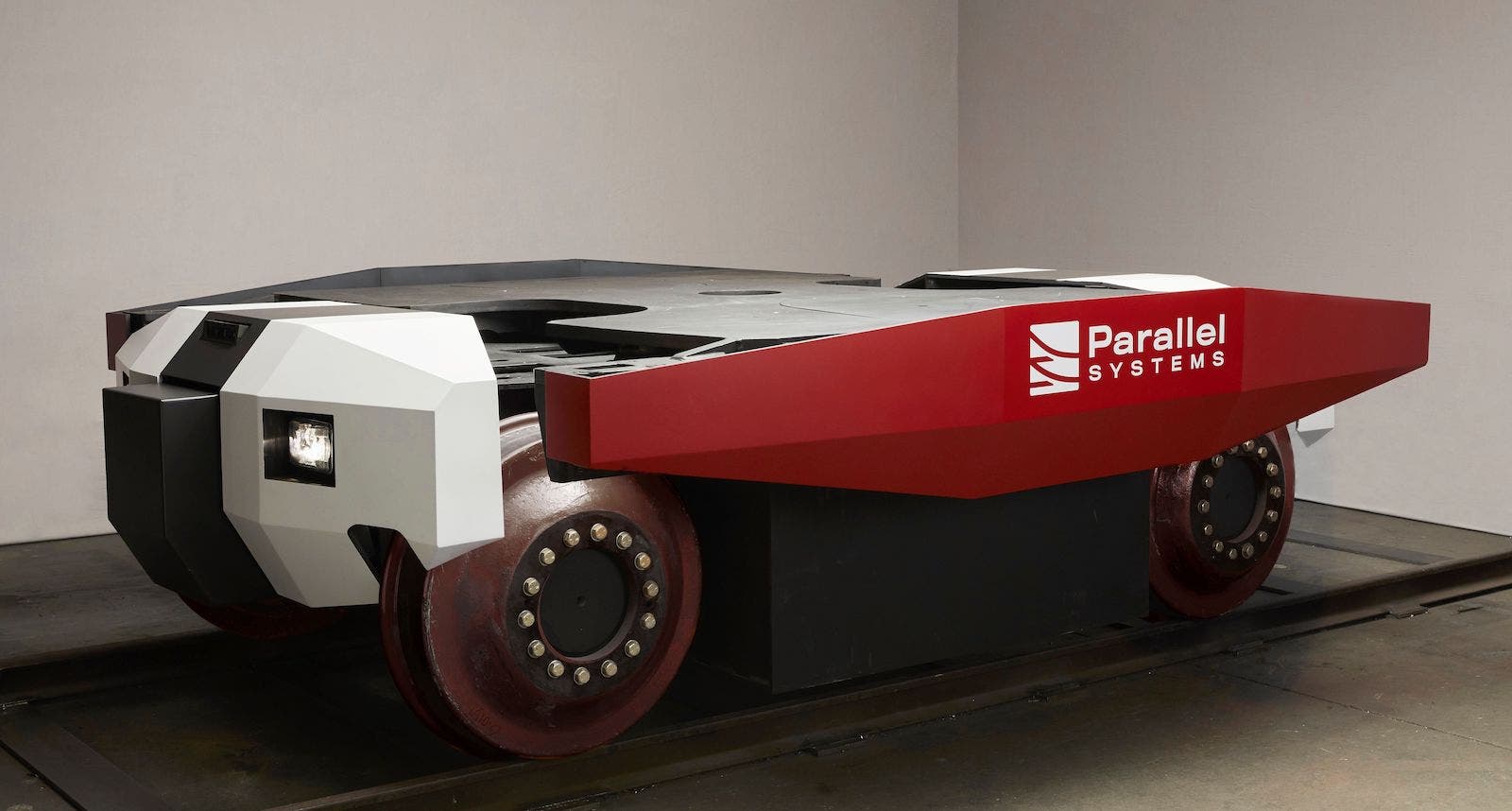Electric Trains To Challenge Electric Trucks For Short-Haul Deliveries
Support CleanTechnica's work through a Substack subscription or on Stripe.

Despite the sudden u-turn in federal energy policy this year, the vehicle electrification movement is well underway and no single person can turn back the clock. One indicator of a permanent, upward trajectory is evident in the shipping and logistics industry, where electric truck makers are fighting tooth and nail amongst each other for a slice of the action. Now electric train stakeholders are also piling on, with one particularly interesting example being the startup Parallel Systems.
The Electric Train Of The Future Is Coming For Your … Electric Trucks
Parallel Systems has created a new electric train concept that leverages the full advantages of today’s battery technology. Instead of electrifying a locomotive, the company has zeroed in on the advantages of equipping individual railcars with their own batteries and autonomous operating systems.
With those systems in hand, the electric train of the future will not need a locomotive. Instead, it will consist of platoons of autonomous railcars. They can travel in groups of 20–30 cars to reduce aerodynamic drag, and they can peel off individually or in smaller groups towards separate destinations along the route, forming and reforming new platoons as they go.
“These smaller, lighter platoons have the potential to flow through freight facilities far more quickly than traditional trains, reducing bottlenecks and lag time and ultimately getting deliveries to their final destinations faster,” explains the Energy Department’s National Renewable Energy Laboratory, which has been collaborating with Parallel and other electric train stakeholders on route optimization strategies.
Parallel first surfaced on the CleanTechnica radar in 2022, in a high-profile launch assisted by the ARPA-E office of the US Department of Energy with the initial aim of clearing noisy, polluting diesel trucks out of the short-haul freight market. That goal can also apply to trucks of any sort, diesel or not.
“With the benefit of zero emission logistics, Parallel Systems foresees at least three use cases that help reduce the need for cumbersome transfers between trucks and trains at key locations, including seaports and warehouses,” CleanTechnica observed in 2023. “The company also envisions the creation of ‘microterminals’ that take up far less land than traditional rail yards, enabling them to be located closer to shippers.”
Group Hug For A New Electric Train
Parallel Systems has not been letting the grass grow under its feet since then. In a LinkedIn post earlier this year, the company noted that it has raised a total of $100 million in funding, including a Series B round of $38 million featuring Anthos Capital in the lead, with participation from Collaborative Fund, Congruent Ventures, Riot Ventures, 8090 Industries, Milano Investment Partners, Embark Ventures, and Interwoven Ventures, among others.
To the delight of trainspotters in Georgia, the company also rolled out plans for its first electric train demonstration in collaboration with the Genesee & Wyoming short-line rail company, leveraging its Heart of Georgia operation. The seven-phase plan, approved by the Federal Railroad Administration, involves 160 miles of track between Pooler and Cordele.
If all goes well, when the Georgia project is completed in 2026, Parallel will have demonstrated the commercial viability of container shipping in an area of Georgia where trucks currently handle much of the job.
US taxpayers can give themselves a pat on the back for that. In addition to a $4.4 million grant from ARPA-E in 2022, the company has benefited from the NREL partnership. That includes a 2024 project in which NREL researchers visited Parallel’s railcars at a test facility in Colorado to provide a series of standard-meeting evaluations leading to FRA approval for the Heart of Georgia demonstration.
The NREL team also collaborated with researchers at the University of Texas in Austin to create a new module of the lab’s ALTRIOS (Advanced Locomotive Technology and Rail Infrastructure Optimization System) platform. Called LIFTS for Line-haul Intermodal Freight Terminal Simulator, the new module enables researchers to assess the movement of containers and other equipment within a freight terminal in excruciating detail, right down to the number of times a crane lifts a container. “Because every unneeded movement costs energy—and money—more efficient operations can quickly create cost savings,” NREL observes.
Optimizing The Electric Railcar
In a long-form article posted on September 24, NREL also gave itself a well-deserved pat on the back. “Parallel’s disruptive concept requires precise engineering, deep understanding of railcar dynamics, and a lot of optimization. That is where NREL researchers come in,” the lab explains.
“Using data gathered during the evaluations, along with vehicle specifications, the research team built Parallel’s railcars into their open-source Advanced Locomotive Technology and Rail Infrastructure Optimization System, called ALTRIOS,” NREL adds.
Jason Lustbader, NREL’s principal investigator for the project, further explains that ALTRIOS provides a birds-eye view of a freight system along with the granular details of individual powertrains and other elements, “It enables ALTRIOS to operate at a high fidelity for single trains and entire rail networks and makes it useful to railroads and manufacturers,” Lustbader notes.
In simulations, NREL researchers calculated that the electric railcars can achieve a 70% cut in container delivery time when combined with an optimized dispatch system. Much of the savings involves the ability to send electric railcar platoons out of the freight yard on demand instead of spending hours to hook up conventional freight trains.
The researchers also found that right-sizing the railcar batteries would result in a range of 500 miles on a single charge, without adding excess battery-related weight and cost.
“They identified the best platoon length to allow for fast, low-energy deliveries of as many containers as possible. And they determined how many platoons Parallel could dispatch without saturating the rail network,” NREL also observes.
The Rural Economic Development Angle
Parallel envisions its nimble, flexible electric train solution as a good fit for rural areas where small-scale freight yards can be built with minimal disruption and less cost.
NREL also emphasizes the benefits for underserved rural communities. “It can also help smaller freight terminals, often located in rural areas, compete with larger facilities,” the lab states.
“In rural communities that have lower demand, the traditional dispatching model is a lot more challenging,” Lustbader adds. “Freight trains need to be big in order to be cost-effective, and you end up seeing trains running less frequently into rural areas.”
Aside from cutting down on local pollution from diesel trucks, the follow-on benefits of railway electrification are clear to anyone who spends any significant amount of time on the US Interstate highway system — namely, fewer trucks on the road, zero emission or not. If you have any thoughts about that, drop a note in the comment thread.
Image (cropped): The US startup Parallel Systems is on the way to commercializing a railcar-based electric train solution, with an assist from the US Department of Energy (courtesy of Parallel Systems via CleanTechnica archive).
 Sign up for CleanTechnica's Weekly Substack for Zach and Scott's in-depth analyses and high level summaries, sign up for our daily newsletter, and follow us on Google News!
Sign up for CleanTechnica's Weekly Substack for Zach and Scott's in-depth analyses and high level summaries, sign up for our daily newsletter, and follow us on Google News!
Have a tip for CleanTechnica? Want to advertise? Want to suggest a guest for our CleanTech Talk podcast? Contact us here.
Sign up for our daily newsletter for 15 new cleantech stories a day. Or sign up for our weekly one on top stories of the week if daily is too frequent.
CleanTechnica uses affiliate links. See our policy here.
CleanTechnica's Comment Policy

